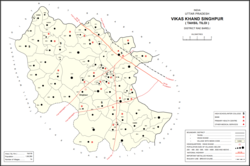Inhauna | |
|---|---|
Village | |
 Map showing Inhauna (#037) in Singhpur CD block | |
| Coordinates: 26°31′28″N 81°29′35″E / 26.524578°N 81.492961°E[1] | |
| Country India | |
| State | Uttar Pradesh |
| District | Raebareli |
| Area | |
| • Total | 8.62 km2 (3.33 sq mi) |
| Population (2011)[2] | |
| • Total | 13,049 |
| • Density | 1,500/km2 (3,900/sq mi) |
| Languages | |
| • Official | Hindi |
| Time zone | UTC+5:30 (IST) |
| PIN | 229308[2] |
| Vehicle registration | UP-33 |
Inhauna is a village and corresponding in Singhpur block of Rae Bareli district, Uttar Pradesh, India.[2] As of 2011, its population is 13,049, in 2,021 households.[2] Located at the junction of the Raebareli-Rudauli and Lucknow-Jaunpur roads, Inhauna is an old town that once served as the seat of a pargana as well as (briefly) a tehsil, and it has the ruins of an old fort built under the Nawabs of Awadh.[3] The old marketplace, known as Ratanganj, was built in 1863 by the tahsildar Ratan Narain.[3] Markets are held twice per week, on Mondays and Thursdays, and most of the trade is in livestock.[4]
History
Inhauna is listed in the late-16th-century Ain-i-Akbari as a mahal in the sarkar of Awadh.[3] It kept this status under the Nawabs of Awadh, under whom a fort was built in the southern part of the village.[3] After the British annexed Oudh State in 1856, Inhauna was made a tehsil headquarters in Sultanpur district.[3] It lost this status in 1869, when it was transferred to Raebareli district as part of a greater administrative reshuffling.[3] Under this new arrangement, Inhauna became part of Maharajganj tehsil.[3] With the tehsil headquarters and police station relocated, Inhauna declined somewhat from a population of 3,974 in 1869 to 3,373 in 1901.[3]
At the turn of the 20th century, Inhauna was described as the only sizeable town in the pargana.[3] It was surrounded by orchards and had a post office, a cattle pound, and a middle vernacular school.[3] To the north of the road to Lucknow was a military encamping ground.[3]
The 1961 census recorded Inhauna as comprising 12 hamlets, with a total population of 4,024 people (2,017 male and 2,007 female), in 906 households and 854 physical houses.[4] The area of the village was given as 2,236 acres.[4] Average attendance of the twice-weekly market was listed as about 3,000 people.[4]
The 1981 census recorded Inhauna as having a population of 4,905 people, in 1,198 households, and having an area of 851.05 hectares.[5]
References
- ^ "Geographic Names Search WebApp". Search for "Inhauna" here.
- ^ a b c d e "Census of India 2011: Uttar Pradesh District Census Handbook - Rae Bareli, Part A (Village and Town Directory)" (PDF). Census 2011 India. pp. 125–41. Retrieved 29 July 2021.
- ^ a b c d e f g h i j k Nevill, H.R. (1905). Rai Bareli: A Gazetteer, Being Volume XXXIX Of The District Gazetteers Of The United Provinces Of Agra And Oudh. Allahabad: Government Press. pp. 108–9, 140, 177–80. Retrieved 29 July 2021.
- ^ a b c d Census 1961: District Census Handbook, Uttar Pradesh (39 - Raebareli District) (PDF). Lucknow. 1965. pp. 173, xviii-xix of section "Maharajganj Tahsil". Retrieved 29 July 2021.
{{cite book}}: CS1 maint: location missing publisher (link) - ^ Census 1981 Uttar Pradesh: District Census Handbook Part XIII-A: Village & Town Directory, District Rae Bareli (PDF). 1982. pp. 46–7. Retrieved 29 July 2021.

